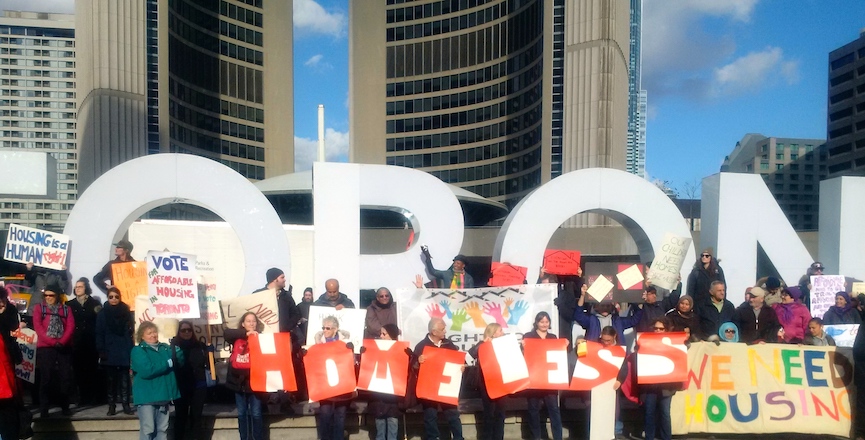Last week, Toronto Mayor Tory and Toronto city council showed their impotence to deal with one of the most severe social welfare disasters in Toronto’s history — homelessness.
The homelessness emergency affects over 8,000 people. Over 1,000 people are living in what can only be compared to refugee camp conditions: respite sites including a disaster dome, overnight drop-ins, and basements of churches and synagogues.
The housing emergency affects close to 200,000 people: 181,000 people are on the social housing wait list and another 16,000 await supportive housing. Essentially neither is being built.
In a debate over whether to declare Toronto’s housing and homelessness crisis an emergency, the directors of Toronto’s emergency management and legal services offices dispassionately addressed language in the Emergency Management and Civil Protection Act, including what entails an “emergency.” Equally dispassionate were the General Manager of Shelter, Support and Housing and the Medical Officer of Health.
Councillor Gord Perks, who brought forth the motion last week with Councillor Kristyn Wong-Tam, attempted to give staff an opening, suggesting that causes out of the city’s control, such as deregulation, could cause a disaster. After all, homelessness and the housing crisis is the direct result of federal and provincial abandonment.
Councillor Wong-Tam pointed out that our general understanding of a disaster is “a flash, a boom, a flood — and people are out on the streets” and that displacement and death are usually sudden, all at once. She argued that at the crux of an emergency is public safety, and that the federal government’s definition applies when there are 10 deceased and 100 people displaced.
At the end of the day, and it was the end of the day because the Mayor had not made the motion one of his key items, the emergency motion failed and council moved on.
Semantics and definitions aside, what could the Mayor and city council have done?
What would declaring homelessness an emergency accomplish? Beyond showing that they have been listening to the public for the last few years and actually care about the city’s population, the following could have been, and could still be, proposed:
- A mayoral statement declaring that homelessness and the social housing situation are an emergency necessitating speedy action.
- An emergency operation team could come together to represent the various relevant silos in Toronto to problem solve and identify immediate issues.
- City staff from various departments including public health, emergency management, parks and recreation could be directed to drop non-urgent work and be deployed to provide support at the various respite sites, warming centre, and overnight drop-ins.
- Public health nurses from the mental health and vulnerable population teams could be assigned to various locations, such as the two 24-hour drop-ins to provide support to people living with mental health issues or suffering trauma.
- The Red Cross could be invited to assist with emergency respite and warming centre operations, as they were in the winter of 2017-2018.
- City buildings could be identified as potential emergency shelter sites.
- The Metro Hall warming centre, only opened during an extreme cold Alert and currently in a hallway, should be immediately moved to a more accessible and comfortable site. In fact, it could just stay open.
- Respites sites with a capacity of 100 or more could have their capacity reduced by one third to improve safety and health.
- The three remaining community resource homelessness structures (“Sprung” structures) could be fast tracked.
- Streets to Homes could implement the recommendations of the Faulkner Inquest, including the provision of survival equipment and supplies (sleeping bags, fire retardant blankets, safe heat sources) to people who are staying outside. I would add tents to this list.
- The City could place a moratorium on evictions of people who are squatting outside.
- The City could expropriate buildings, which are being left unused and vacant by owners, for immediate conversion to social housing such as single room dwellings or transitional housing.
- The City could create an emergency rent bank or rent supplement program to prioritize housing vulnerable people including seniors and people with disabilities.
- The City could hold a press conference requesting provincial aid to deal with the emergency.
- The City could tour the federal ministers and MPs responsible for housing to show them first hand the need for emergency funding and demand assistance.
Mayor Tory and City Council would do well to remember Jack Layton’s words: “I’ve always favoured proposition over opposition.”
So, don’t just vote “no.” Do something.
Cathy Crowe is a street nurse, author and filmmaker who works nationally and locally on health and social justice issues. She has fostered numerous coalitions and advocacy initiatives that have achieved significant public policy victories. Her website is www.cathycrowe.ca. Follow her on Twitter @cathyacrowe
Image: Cathy Crowe
Help make rabble sustainable. Please consider supporting our work with a monthly donation. Support rabble.ca today for as little as $1 per month!





